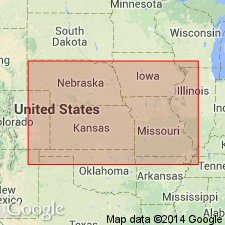
- Usage in publication:
-
- Heumader shale member
- Modifications:
-
- Original reference
- Dominant lithology:
-
- Shale
- AAPG geologic province:
-
- Forest City basin
Summary:
Pg. 94, 96. Heumader shale member of Oread limestone of Shawnee group. Thin shale near top of Oread limestone, underlying Kereford limestone member and overlying Plattsmouth limestone member. Age is Late Pennsylvanian (Virgil). [On p. 52 it is described as consisting of 2 feet of dark-bluish shale with thin yellow streaks.]
Source: US geologic names lexicon (USGS Bull. 896, p. 949); GNC KS-NE Pennsylvanian Corr. Chart, sheet 2, Oct. 1936.

- Usage in publication:
-
- Heumader shale member
- Modifications:
-
- Principal reference
- Dominant lithology:
-
- Shale
- AAPG geologic province:
-
- Forest City basin
Summary:
Pg. 48, 167-168. Heumader shale member of Oread limestone of Shawnee group. The few feet of shale that lies between base of Kereford limestone, where that member is present, and top of Plattsmouth limestone may be termed Heumader shale and classed as a member of Oread formation. The shale is clayey to sandy and usually appears dark gray. Thickness almost 0 to 10 feet. Where Kereford limestone is absent the Heumader and possibly shaly equivalents of the Kereford are not differentiated. Although stratigraphic continuity with units classified as parts of Oread formation is recognized, the shale next above the Plattsmouth is then included with Kanwaka shale. Age is Late Pennsylvanian (Virgil).
Type locality: Heumader quarry, bluffs of Missouri River just north of St. Joseph, Buchanan Co., northwestern MO.
Source: US geologic names lexicons (USGS Bull. 896, p. 949; USGS Bull. 1200, p. 1748-1749); GNC KS-NE Pennsylvanian Corr. Chart, sheet 2, Oct. 1936.
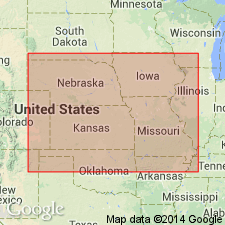
- Usage in publication:
-
- Heumader shale member*
- Modifications:
-
- Overview
Summary:
Pg. 2035 (fig. 5). Heumader shale member of Oread formation. Underlies kereford limestone member; overlies Plattsmouth limestone member. Age is Late Pennsylvanian (Virgilian). This is classification agreed upon by State Geol. Surveys of Iowa, Kansas, Missouri, Nebraska, and Oklahoma, May 1947.
Source: US geologic names lexicon (USGS Bull. 1200, p. 1748-1749).
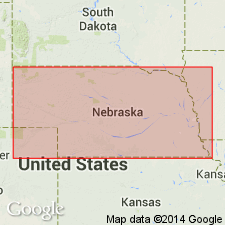
- Usage in publication:
-
- Heumader shale member*
- Modifications:
-
- Areal extent
Summary:
Pg. 25. Heumader shale member of Oread formation. Thickness in southeastern Nebraska 2 to 4 feet. Age is Late Pennsylvanian (Virgilian).
Source: US geologic names lexicon (USGS Bull. 1200, p. 1748-1749).
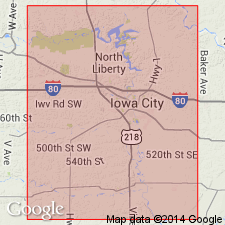
- Usage in publication:
-
- Heumader shale member*
- Modifications:
-
- Areal extent
- AAPG geologic province:
-
- Iowa shelf
Summary:
Pg. 418 (fig. 1), 419. Heumader shale member of Oread formation. Thickness 7 feet in section measured near Winterset, Madison County, southwestern Iowa. Age is Late Pennsylvanian (Virgilian).
Source: US geologic names lexicon (USGS Bull. 1200, p. 1748-1749).
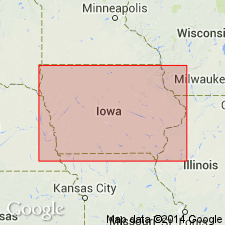
- Usage in publication:
-
- Heumader shale member*
- Modifications:
-
- Areal extent
Summary:
Pg. 21, fig. 5. Heumader shale member of Oread formation. Olive green, brown, black; locally black carbonaceous zones and black subfissile beds. Average thickness 3 feet. Overlies Plattsmouth limestone member; underlies Kereford member; where Kereford is missing, underlies Kanwaka shale. Age is Late Pennsylvanian (Virgilian).
Source: US geologic names lexicon (USGS Bull. 1200, p. 1748-1749).
For more information, please contact Nancy Stamm, Geologic Names Committee Secretary.
Asterisk (*) indicates published by U.S. Geological Survey authors.
"No current usage" (†) implies that a name has been abandoned or has fallen into disuse. Former usage and, if known, replacement name given in parentheses ( ).
Slash (/) indicates name conflicts with nomenclatural guidelines (CSN, 1933; ACSN, 1961, 1970; NACSN, 1983, 2005, 2021). May be explained within brackets ([ ]).

